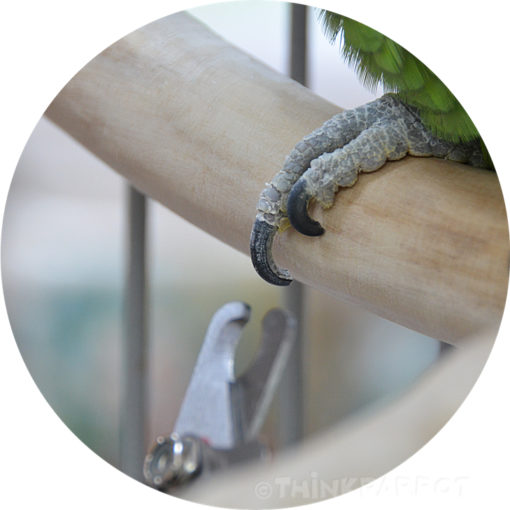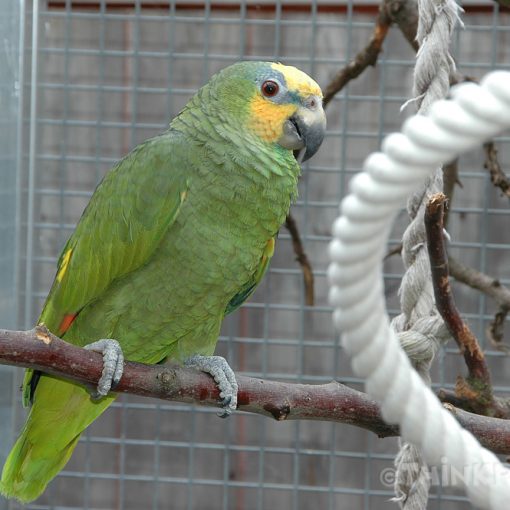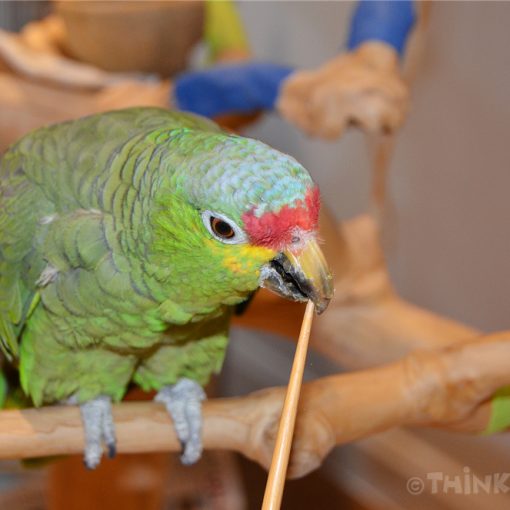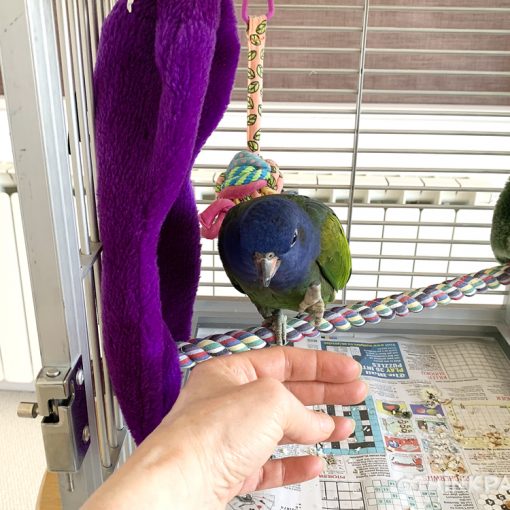Biting is communication. Usually it means “No!” or “I’m not comfortable”, but can also be a response to over excitement or even as a way of getting social interaction.
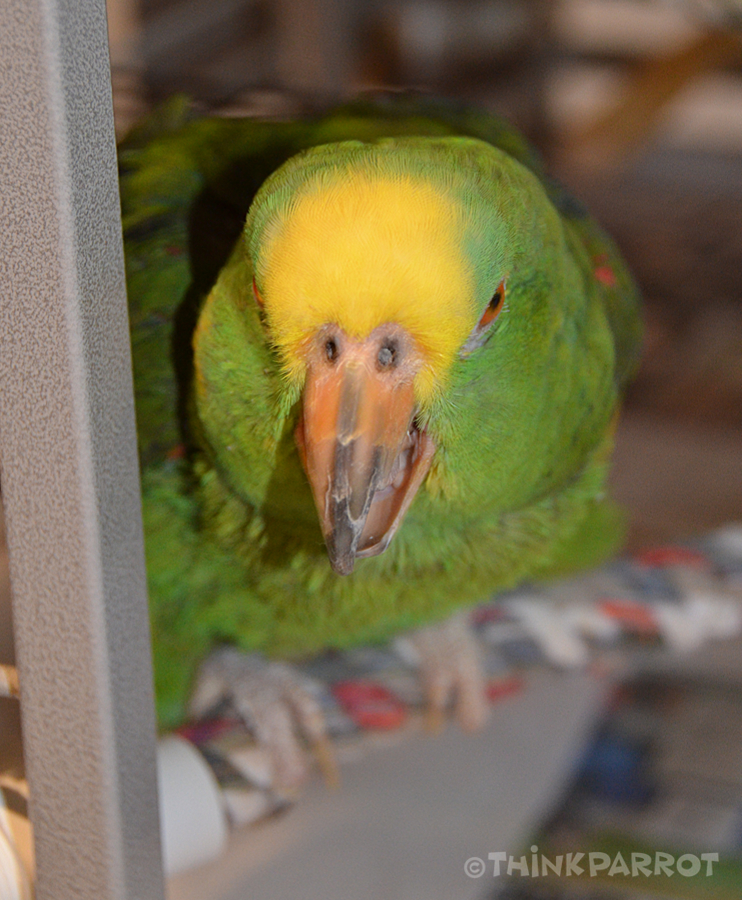
Body Language
Before the bite a parrot will usually give loads of very obvious (to the parrot) body language to say, “I’m not comfortable.” If we humans can’t, or won’t, read and heed that information, the parrot has no option but to escalate his behaviour to communication the human does understand. The bite!
If we keep ignoring the body language, the parrot will learn not to bother to give any at all and go straight for the bite which makes for an unpredictable and dangerous bird.
How do we know the parrot means “NO!” or “GO AWAY!”? We just have to look at the immediate consequence of the bite – we snatch our painful body part away and likely retreat! Or for the social interaction, we yell!
Learn to read your parrot’s body language
Take note of what ‘relaxed’, ‘excited’, ‘fearful’, etc looks like in your bird. Maybe relaxed is feathers fluffed up a little on the head and body, sitting on one foot, and blinking, oval shaped eyes. What does excited look like? Perhaps spread tail, head feathers raised, eyes round and pinning, pacing or swaying from side to side? Probably not a good time to offer a hand!
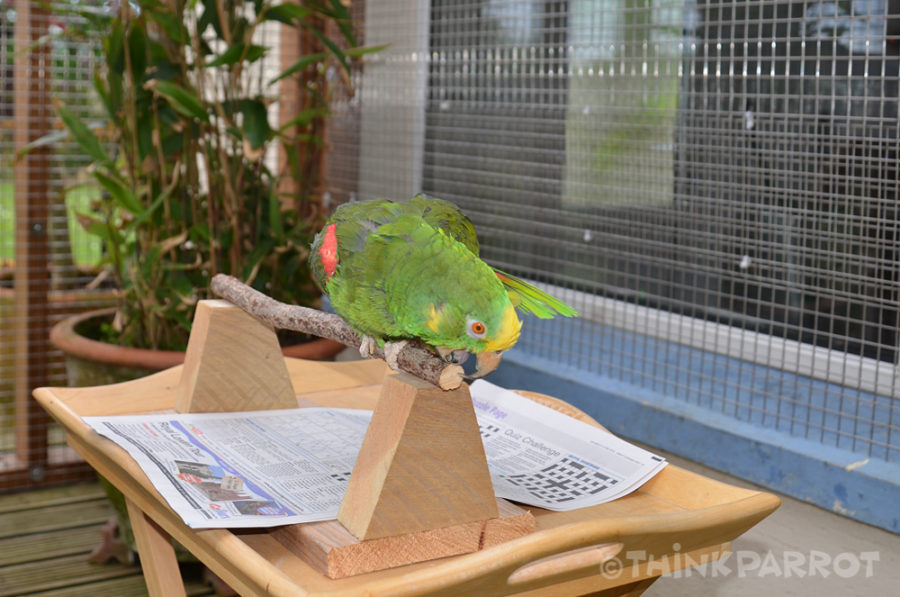
What was the body language that preceded the bite? Maybe the eyes widened and he leaned away a little? Perhaps the feathers on the head and shoulders rose? Or maybe he lowered his body and opened his beak in warning? Perhaps he hissed/breathed heavily or growled. If in doubt don’t offer your hand.
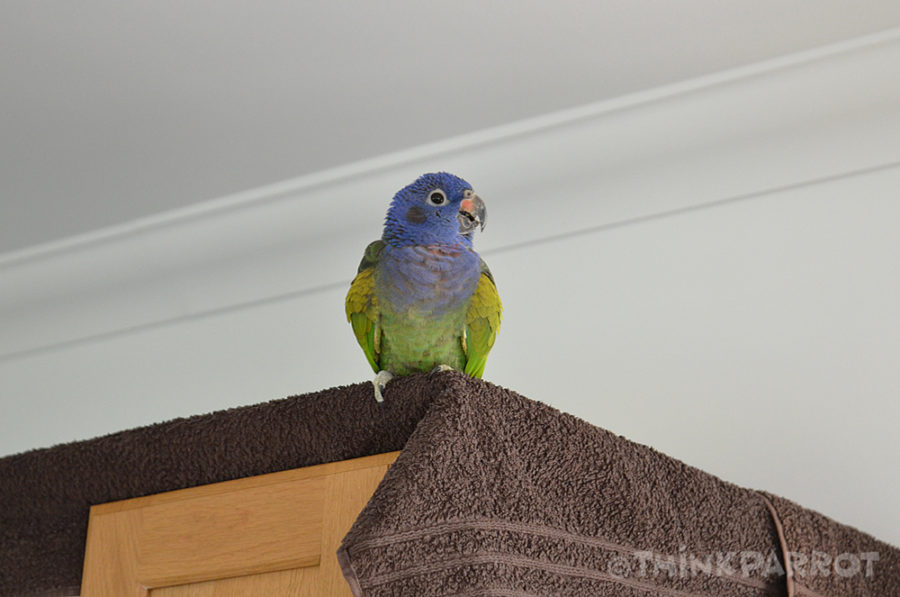
It takes time to learn your parrot’s body language. I remember fairly soon after the baby Kobe arrived, he came charging out from behind a cushion, his little face and body puffed right up. I thought, “oh how cute, he’s going to snuggle up to my face like my budgie!” Obviously my budgie’s happy body language didn’t include charging and breathing heavily. Yes I got bitten hard on my nose. A harsh but fast lesson!
What did I do before the bite?
Ask yourself, “what did I do immediately before the bite? How can I do it differently next time?” This is important, because if you don’t change your own behaviour, you are teaching the bird to bite more in that scenario.
For example, if you were asking the bird to step up from inside his cage, consider simply opening the door and letting him climb out on his own. Parrots can be uncomfortable if you encroach on their territory. I think this should be respected – I rarely ask a bird to step up from inside his cage, only if I see body language that says, “I really, REALLY want a lift!” I will ask a bird to step out of a travel/night cage, but again only after checking body language to see if it is ok. If the bird isn’t ready to come out, I just wait a minute and ask again later. For Kobe, I might swing his decision in my favour by moving as if to leave the room which immediately changes his body language into, “I really, REALLY want to come out!”
The parrot bit your ear when she was on your shoulder? Don’t allow her on your shoulder. There is no way you can see her body language up there.
He was on your arm and nailed you when you reached to pick up the TV remote/towel/weird object? Don’t pick up the remote/towel/weird object when the bird is on your arm next time. Work on desensitizing him to the object by exposing him to the item in small manageable stages, so as never to elicit more than the slightest of reactions.
Your partner/another parrot came too close when you were skritching her head? Next time stop skritching before that person/bird gets too near. When interacting with parrots always be aware of what is going on in the environment.
He bit your hand when you reached in to change the food/water bowls? Get a cage with bowls that swing out externally and/or teach the bird to target/station to a perch on the other side of the cage for a lovely treat.
She bit when she got over excited whilst playing with your hand? Stop play/freeze for a moment if play begins to get too rough until she has calmed down, then resume at a gentler pace.
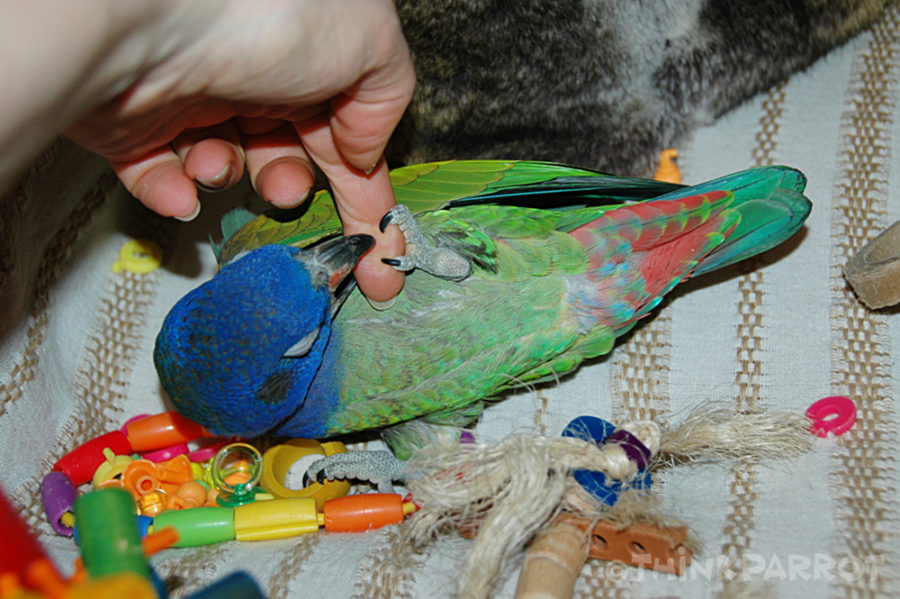
He lured me in for a bite! Chico used to, and very occasionally still does this. He puts his head down for a head rub and then WHAM! He would attempt to bite! First I assess his body language to see what sort of mood he’s in, and second, if I decide it is safe to give him a head rub, I watch his head very closely. Any flicker of an eye lid or slight movement of feathers around his beak, I immediately withdraw my fingers. I pretty much always stop before he even thinks of biting. If the bird is likely to bite after 4 seconds, stop at 2 seconds and gradually build up the time, carefully watching that body language. Likewise if the bird nails you after sitting for a while on your hand or arm, say after 10 seconds, ask him to step off after 5 or 6 seconds (don’t forget to reinforce the step down!) and slowly build up duration from there, again always watching his body language for clues.
Antecedents
Note all these solutions address the antecedents – they take place BEFORE the parrot bites. Antecedents set the stage for, or cue, the behaviour. This is because it is too late to do anything AFTER the bite. The deed is done. No amount of punishment, time outs, yelling, etc is going to change that.
Arrange the environment so the parrot is successful
Reinforce behaviours you want to see more of. If a parrot bites because he doesn’t want to go back into his cage, make stepping down and cage time highly reinforcing so he’ll want to go in, in the future. Maybe a favourite treat for stepping down onto the cage perch, and gently close the door while he is eating it so that he pairs the closing door with a good experience. Add some interesting toys or foraging opportunities, or a fresh food bowl if he’s going to be spending some time in there.

Likewise, if you want a parrot to step up willingly without biting, highly reinforce the step up!
My Parrot bites when I ask him to step up
First check whether you are indeed asking, i.e. giving him a choice (which is reinforcing in itself), or commanding (no choice). What’s his body language saying? How are you presenting your hand? Is it too fast, too close, pressing against the chest (negative reinforcement)? Are you smiling and relaxed, or impatient and scowling? It makes a difference!
There is still the old school advice floating around the internet about pressing the hand against the parrot’s chest in order to get him to step up. However gently you may be pressing, it is negative reinforcement, also known as escape/avoidance learning. The bird steps up in order to escape/avoid an aversive (the uncomfortable pressure to the chest). Many parrots quickly learn to bite instead to make the hand go away.
Choice and positive reinforcement
Success is much more likely if you allow the parrot to choose to step up by offering the hand a step or two away from the bird. Make that step up absolutely worth it by reinforcing the behaviour with something desirable – a yummy treat, praise, or carrying him somewhere he likes to hang out – whatever is highly reinforcing for that individual parrot. You might want to kick start the behaviour by briefly showing him the treat first. See more about teaching your parrot to step up here.
Trust and success
There is a lot of trust involved on the parrot’s part to be confident enough to step up onto a hand. If lack of confidence/trust is the problem then start off by teaching the bird a much simpler task like targeting. Whilst teaching this skill, the parrot will be learning how to be successful, and earning lots of wonderful reinforcing consequences along the way. This in turn pairs you with the good experiences and therefore builds trust. When you have a good rapport with the bird, then have a go at shaping the step up either onto your hand, or a hand held perch if you are not confident about offering your hand yet.
You can even have the bird target into or out of his cage. No need for the step up at all whilst working on training the behaviour. Likewise targeting comes in useful to get the bird to station to a perch the opposite end of the cage, maybe for a favourite treat, allowing you to safely slot in or take out the food and water bowls. Win win!
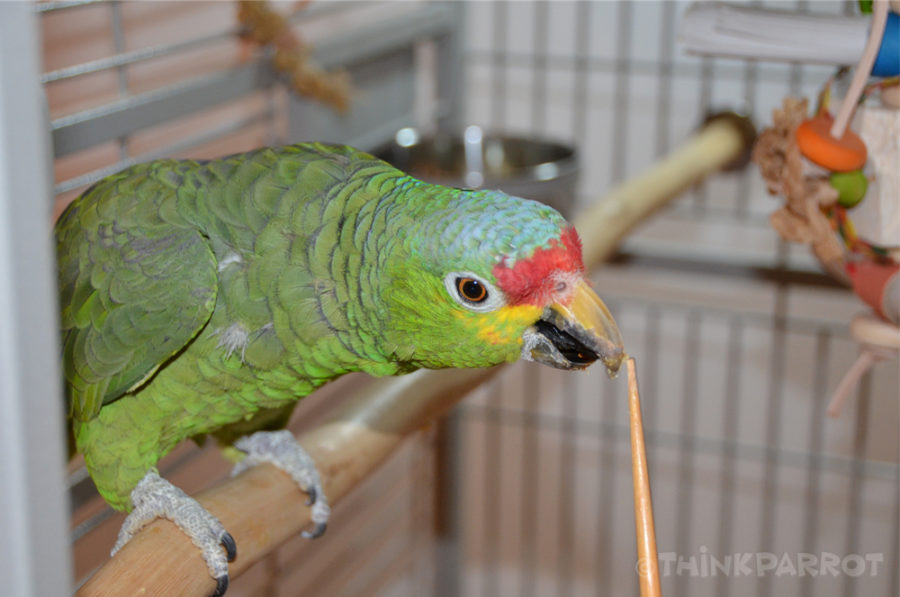
My Parrot bites when I offer him a treat
Don’t make the bird work through fear or aggression in order to take the treat. Wait until he shows relaxed body language and is able to take the treat calmly. For some individuals it means doing some work first to be able to approach the bird and him remain relaxed. There are various methods including desensitization which is exposing him to your approach in small manageable stages so as never to elicit more than the slightest of reactions, or negative reinforcement (sometimes we can use R- in a kind way) as discussed in Fearful Parrots and How to Tame/Gain Their Trust or CAT explained in Aggression in Parrots.
If the bird is not comfortable with your fingers close to him, begin by offering a large piece of favoured food – a slice of apple, a palm nut, one end of a length of millet spray, a whole nut etc. This keeps your fingers at a mutually safe distance.
Try offering the food through the bars of the cage first so that you are both protected by the bars. When this is going well, gradually break the food/treats into smaller pieces so that the parrot gets used to being increasingly closer to your fingers. Then change to offering sometimes through the open door (ie. no bars), and then outside the cage. Go slowly at the parrot’s pace – read and heed his body language.
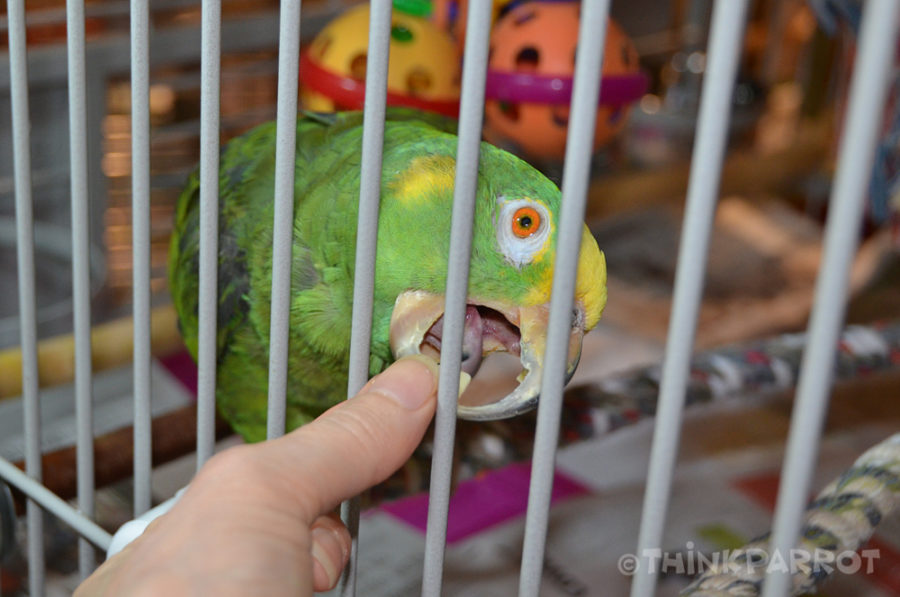
Tip: make the bird stretch upwards for the treat – it is hard to lunge/bite when your neck is at full stretch. Stretching also confirms that the parrot wants the treat and you are not forcing it on him which again ensures against a bite.
As the treats get smaller, hold the item between your thumbnail and the nail of your first finger so that if the parrot does try to bite, his beak will slip off your nails.
Preferably try to work it so that the parrot doesn’t feel he needs to lunge/bite. On the rare occasion he does, drop the treat and calmly walk away – lunging/biting = no treat.
Other ways of delivering treats are perhaps offering them in a small treat bowl or even seeing if he will take them from the end of a wooden spoon. Whatever works for your individual bird.
Lunging at hands
If the bird lunges at your hands when they are too close, avoid putting them too close to him for the time being. When you are able, pair your hands with good experiences like treats (big items to start with), or hand him favourite foot toys, so he begins to trust them. You have all the time in the world – go slowly. If you go too fast for the bird, you will keep losing the trust you are so painstakingly building. It took me six months of careful desensitizing mixed with positive reinforcement to be able to touch Ollie the Orange-winged Amazon’s head for a short head skritch – something I never thought possible when he first arrived.
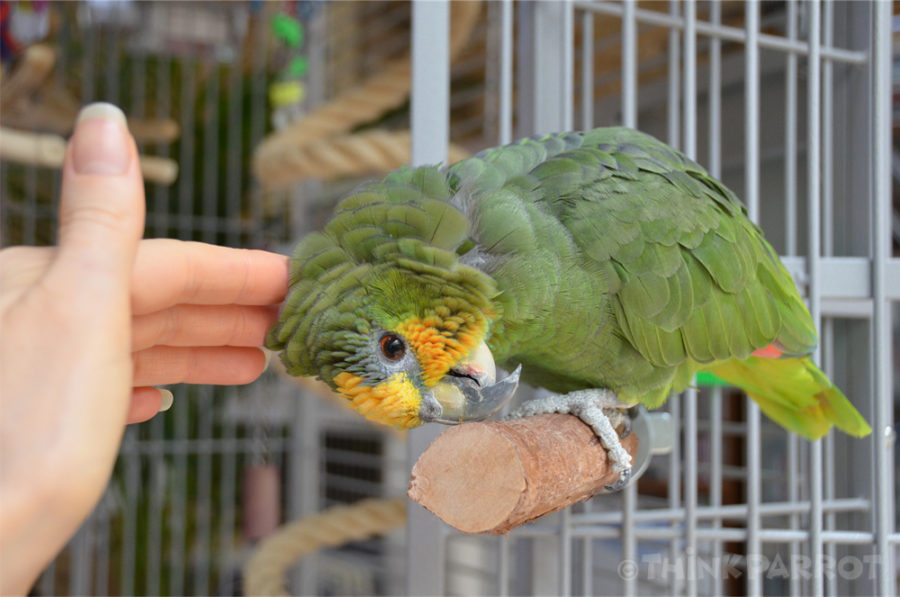
Unwanted attention/affection may also result in biting. Many birds don’t like to be petted or stroked like a cat or dog. Heed and respect that body language – is he saying no? If you do desensitize him to being petted, be careful of where you are touching him. Snuggling with him or stroking his back and under the wings suggests to an adult parrot that you want to set up a nest with him and rear young. Hands off if you get a sexual response or more unwanted problems can occur. Read more about hormones in Aggression in Parrots.
If you are preening his head – rubbing off the waxy sheaths to new feathers, and accidently poke a pin feather it will hurt him, and again, he may well lunge or bite.
A parrot who isn’t sure of how steady a hand is, may use his beak to step up. This isn’t biting even though it may look like it. If you keep snatching your hand away in fear, the parrot is going to grip harder with his beak next time to try to stop the hand moving. If you are not yet confident about having a bird step up on your hands – that beak can look scary! – then teach him to step up on a hand held perch first until you get to know him.
What do I do if the bird bites?
Many a time we are told to ignore the bite. This is terrible advice. It suggests to the bird his attempt at communication has not been heard, that he has no control over his environment. You are actually putting him in a position of learned helplessness which results in loss of trust and he has no option but to bite increasingly harder to try to make himself understood.
If contact has been made, show him it hurts but don’t go over the top in your reaction or else he’ll be looking for a wonderful high energy ‘drama reward’ next time.
Try your best to diffuse the situation/remove any reinforcement for the biting by putting him down if he’s on you, and walking away.
But I repeat, the best way to deal with biting is to avoid getting bitten in the first place, because if the parrot learns to bite in certain situations he is likely to do it again if nothing changes – you can’t unlearn what you already know.
Time Out
Other advice we often hear about is time out. This is fine if the time out is putting him down and briefly turning your back on him, before then giving him a chance to earn reinforcement for doing another more acceptable behaviour.
However, the time out usually advised, which is putting the bird back into his cage, poses three problems:
- You don’t want him to think of his cage as being somewhere aversive and therefore avoids going into, in the future.
- By the time you have put him into the cage, via chasing or catching (both aversives to the bird), or carrying him maybe across the room or into another room, he will have no idea why he’s being shut away. The moment has been lost (ie. the punishment for the bite) – AND he will pair you with the negative emotions/aversives around the scenario.
- He may learn that when he wants to go back into his cage, all he has to do is bite!
Punishment
Punishment is NOT the way to go either. There are too many fall outs to punishment, which include loss of trust, apathy, fear, phobia and, on the other end of the scale, aggression. Punishment is not a good teacher.
A quick note about gloves – please don’t use them! They don’t fix the reason for the biting, and are often terrifying for the bird. They make things worse because you are less likely to heed body language and more likely to use force, which causes more biting! It’s so much more rewarding to have the bird step up because he wants to. If you are fearful of having the bird step up onto your hands, teach him to step up onto something else first – a hand held perch, a basket handle, a folded rope perch, the top of a travel cage/carrier, even the back of a chair. If you choose something he is used to/not fearful of, spending time desensitizing him to it can be minimal. When you have a better relationship with the parrot then you can teach him to step up onto your hand using shaping. It might be he is perfectly willing to step up on your hand away from his cage/territory.
Biting doesn’t have to be a requisite of living with a parrot
Learning to be sensitive to your individual parrot’s body language, with thoughtful arrangement of the antecedents and plenty of highly reinforcing consequences for desired behaviour, there will be no need for a parrot to resort to biting.
There is more discussion on this topic in Aggression in Parrots.
References
Pamela Clark’s Avoiding Aggression with Start Buttons: https://blogpamelaclarkonline.com/2019/01/31/parrot-and-start-buttons/
Dr Susan Friedman’s Parrots in Temporary Shelters: https://www.behaviorworks.org/files/articles/Parrots%20in%20Temporary%20Shelters%202004.pdf
Jenny Drummey’s book: Biting Matters Living Bite-free With Your Parrot. 2010. Phoenix Landing Press

